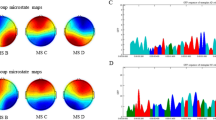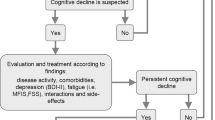Abstract
Visual disturbances are a common disease manifestation in multiple sclerosis (MS) due to lesions damaging white matter tracts involved in vision. Vertical occipital fasciculus (VOF), a tract located vertically in the occipital lobe, was neglected for more than a century. We hypothesize that VOF is involved in integrating information between dorsal and ventral visual streams. Thus, its damage in MS, as well as its probable role in visual processing (by using MS as a VOF damage model) needs to be clarified. To study fiber characteristics of VOF in MS, and their clinical and visual learning associations, 57 relapsing–remitting MS (RRMS) and 25 healthy controls (HC) were recruited. We acquired MS Functional Composite, Expanded Disability Status Scale (EDSS), and Brief Visuospatial Memory Test-Revised (BVMT-R), and diffusion MRI scans. Tractography of VOF and optic radiation (OR) was done. VOF’s metrics were statistically tested for between-group differences and clinical and visual tests associations. Along-tract analysis and laterality were also tested. RRMS patients had higher mean, axial, and radial diffusivity (nearly in all fiber points), and lower fractional anisotropy in bilateral VOFs compared to HC. No laterality was noted. These were associated with poor clinical outcomes, poor visual scores in EDSS, and lower total immediate and delayed recall in BVMT-R in RRMS, after adjusting for age, gender, and fiber metrics of OR. VOF damage is present in RRMS and is associated with visual symptoms and visuospatial learning impairments. It seems VOF is involved in integrating information between visual streams.




Similar content being viewed by others
Availability of data and materials
To access the CRIMSON project data, please contact Dr. Arash Nazeri: arashnazeri[at]gmail[dot]com.
Code availability
The neuroimaging pipeline and statistical R codes are available upon request.
References
Amano K, Wandell BA, Dumoulin SO (2009) Visual field maps, population receptive field sizes, and visual field coverage in the human MT+ complex. J Neurophysiol 102(5):2704–2718
Amemiya K, Naito E, Takemura H (2021) Age dependency and lateralization in the three branches of the human superior longitudinal fasciculus. Cortex 139:116–133. https://doi.org/10.1016/j.cortex.2021.02.027
Avesani P, McPherson B, Hayashi S, Caiafa CF, Henschel R, Garyfallidis E et al (2019) The open diffusion data derivatives, brain data upcycling via integrated publishing of derivatives and reproducible open cloud services. Sci Data 6(1):69. https://doi.org/10.1038/s41597-019-0073-y
Baker LM, Laidlaw DH, Conturo TE, Hogan J, Zhao Y, Luo X et al (2014) White matter changes with age utilizing quantitative diffusion MRI. Neurology 83(3):247. https://doi.org/10.1212/WNL.0000000000000597
Balcer LJ, Miller DH, Reingold SC, Cohen JA (2015) Vision and vision-related outcome measures in multiple sclerosis. Brain 138(1):11–27. https://doi.org/10.1093/brain/awu335
Benedict RHB, Schretlen D, Groninger L, Dobraski M, Shpritz B (1996) Revision of the Brief Visuospatial Memory Test: studies of normal performance, reliability, and validity. Psychol Assess 8(2):145–153. https://doi.org/10.1037/1040-3590.8.2.145
Benjamini Y, Hochberg Y (1995) Controlling the false discovery rate: a practical and powerful approach to multiple testing. J R Stat Soc: Ser B (methodol) 57(1):289–300. https://doi.org/10.1111/j.2517-6161.1995.tb02031.x
Budisavljevic S, Dell’Acqua F, Zanatto D, Begliomini C, Miotto D, Motta R, Castiello U (2017) Asymmetry and structure of the fronto-parietal networks underlie visuomotor processing in humans. Cereb Cortex 27(2):1532–1544. https://doi.org/10.1093/cercor/bhv348
Budisavljevic S, Dell’Acqua F, Castiello U (2018) Cross-talk connections underlying dorsal and ventral stream integration during hand actions. Cortex 103:224–239. https://doi.org/10.1016/j.cortex.2018.02.016
Debernard L, Melzer TR, Alla S, Eagle J, Van Stockum S, Graham C et al (2015) Deep grey matter MRI abnormalities and cognitive function in relapsing-remitting multiple sclerosis. Psychiatry Res: Neuroimaging 234(3):352–361. https://doi.org/10.1016/j.pscychresns.2015.10.004
Denier N, Walther S, Schneider C, Federspiel A, Wiest R, Bracht T (2020) Reduced tract length of the medial forebrain bundle and the anterior thalamic radiation in bipolar disorder with melancholic depression. J Affect Disord 274:8–14. https://doi.org/10.1016/j.jad.2020.05.008
Eshaghi A, Riyahi-Alam S, Roostaei T, Haeri G, Aghsaei A, Aidi MR et al (2012) Validity and reliability of a persian translation of the minimal assessment of cognitive function in multiple sclerosis (MACFIMS). Clin Neuropsychol 26(6):975–984. https://doi.org/10.1080/13854046.2012.694912
Filippi M, Cercignani M, Inglese M, Horsfield MA, Comi G (2001) Diffusion tensor magnetic resonance imaging in multiple sclerosis. Neurology 56(3):304. https://doi.org/10.1212/WNL.56.3.304
Filippi M, Bar-Or A, Piehl F, Preziosa P, Solari A, Vukusic S, Rocca MA (2018) Multiple sclerosis. Nat Rev Dis Primers 4(1):43. https://doi.org/10.1038/s41572-018-0041-4
Fischer JS, Rudick RA, Cutter GR, Reingold SC (1999) The Multiple Sclerosis Functional Composite measure (MSFC): an integrated approach to MS clinical outcome assessment. Mult Scler J 5(4):244–250. https://doi.org/10.1177/135245859900500409
Frey SH (2007) What puts the how in where? Tool use and the divided visual streams hypothesis. Cortex 43(3):368–375. https://doi.org/10.1016/S0010-9452(08)70462-3
Goddard E, Mannion DJ, McDonald JS, Solomon SG, Clifford CW (2011) Color responsiveness argues against a dorsal component of human V4. J vis 11(4):3–3
Greenblatt SH (1973) Alexia without agraphia or hemianopsia anatomical analysis of an autopsied case 1. Brain 96(2):307–316. https://doi.org/10.1093/brain/96.2.307%JBrain
Greenblatt SH (1976) Subangular alexia without agraphia or hemianopsia. Brain Lang 3(2):229–245. https://doi.org/10.1016/0093-934X(76)90019-5
Grill-Spector K, Kushnir T, Edelman S, Itzchak Y, Malach R (1998) Cue-invariant activation in object-related areas of the human occipital lobe. Neuron 21(1):191–202
Harris NG, Verley DR, Gutman BA, Sutton RL (2016) Bi-directional changes in fractional anisotropy after experiment TBI: Disorganization and reorganization? Neuroimage 133:129–143. https://doi.org/10.1016/j.neuroimage.2016.03.012
Jeurissen B, Tournier J-D, Dhollander T, Connelly A, Sijbers J (2014) Multi-tissue constrained spherical deconvolution for improved analysis of multi-shell diffusion MRI data. Neuroimage 103:411–426. https://doi.org/10.1016/j.neuroimage.2014.07.061
Jitsuishi T, Hirono S, Yamamoto T, Kitajo K, Iwadate Y, Yamaguchi A (2020) White matter dissection and structural connectivity of the human vertical occipital fasciculus to link vision-associated brain cortex. Sci Rep 10(1):1–14
Jones DK, Knösche TR, Turner R (2013) White matter integrity, fiber count, and other fallacies: the do’s and don’ts of diffusion MRI. Neuroimage 73:239–254. https://doi.org/10.1016/j.neuroimage.2012.06.081
Klistorner A, Vootakuru N, Wang C, Yiannikas C, Graham SL, Parratt J et al (2015) Decoding diffusivity in multiple sclerosis: analysis of optic radiation lesional and non-lesional white matter. PLoS ONE 10(3):e0122114
Kurtzke JF (1983) Rating neurologic impairment in multiple sclerosis. Neurology 33(11):1444. https://doi.org/10.1212/WNL.33.11.1444
Latini F, Mårtensson J, Larsson E-M, Fredrikson M, Åhs F, Hjortberg M et al (2017) Segmentation of the inferior longitudinal fasciculus in the human brain: a white matter dissection and diffusion tensor tractography study. Brain Res 1675:102–115. https://doi.org/10.1016/j.brainres.2017.09.005
Lebel C, Beaulieu C (2009) Lateralization of the arcuate fasciculus from childhood to adulthood and its relation to cognitive abilities in children. Hum Brain Mapp 30(11):3563–3573. https://doi.org/10.1002/hbm.20779
Lerma-Usabiaga G, Mukherjee P, Ren Z, Perry ML, Wandell BA (2019) Replication and generalization in applied neuroimaging. Neuroimage 202:116048. https://doi.org/10.1016/j.neuroimage.2019.116048
McKeefry DJ, Burton MP, Vakrou C, Barrett BT, Morland AB (2008) Induced deficits in speed perception by transcranial magnetic stimulation of human cortical areas V5/MT+ and V3A. J Neurosci 28(27):6848–6857
McPherson B (2018) mrtrix3 preprocess. In: brainlife.io.
Migliore S, Ghazaryan A, Simonelli I, Pasqualetti P, Squitieri F, Curcio G et al (2017) Cognitive impairment in relapsing-remitting multiple sclerosis patients with very mild clinical disability. Behav Neurol 2017:7404289. https://doi.org/10.1155/2017/7404289
Panesar SS, Yeh F-C, Jacquesson T, Hula W, Fernandez-Miranda JC (2018) A quantitative tractography study into the connectivity, segmentation and laterality of the human inferior longitudinal fasciculus. Front Neuroanat 12:47
Panesar SS, Belo JTA, Yeh F-C, Fernandez-Miranda JC (2019) Structure, asymmetry, and connectivity of the human temporo-parietal aslant and vertical occipital fasciculi. Brain Struct Funct 224(2):907–923. https://doi.org/10.1007/s00429-018-1812-0
Petzold A, Wattjes MP, Costello F, Flores-Rivera J, Fraser CL, Fujihara K et al (2014) The investigation of acute optic neuritis: a review and proposed protocol. Nat Rev Neurol 10(8):447–458
Postle BR, Stern CE, Rosen BR, Corkin S (2000) An fMRI investigation of cortical contributions to spatial and nonspatial visual working memory. Neuroimage 11(5):409–423. https://doi.org/10.1006/nimg.2000.0570
R Core Team (2019) R: A language and environment for statistical computing. In: R Foundation for Statistical Computing, Vienna
Ren Z, Zhang Y, He H, Feng Q, Bi T, Qiu J (2019) The different brain mechanisms of object and spatial working memory: voxel-based morphometry and resting-state functional connectivity. Front Hum Neurosci. https://doi.org/10.3389/fnhum.2019.00248
Roostaei T, Sadaghiani S, Mashhadi R, Falahatian M, Mohamadi E, Javadian N et al (2019) Convergent effects of a functional C3 variant on brain atrophy, demyelination, and cognitive impairment in multiple sclerosis. Mult Scler 25(4):532–540. https://doi.org/10.1177/1352458518760715
RStudio Team (2016) RStudio: integrated development environment for R
Schmidt H, Knösche TR (2019) Action potential propagation and synchronisation in myelinated axons. PLoS Comput Biol 15(10):e1007004. https://doi.org/10.1371/journal.pcbi.1007004
Seizeur R, Magro E, Prima S, Wiest-Daesslé N, Maumet C, Morandi X (2014) Corticospinal tract asymmetry and handedness in right- and left-handers by diffusion tensor tractography. Surg Radiol Anatomy : SRA 36(2):111–124. https://doi.org/10.1007/s00276-013-1156-7
Silson EH, McKeefry DJ, Rodgers J, Gouws AD, Hymers M, Morland AB (2013) Specialized and independent processing of orientation and shape in visual field maps LO1 and LO2. Nat Neurosci 16(3):267
Silver MA, Ress D, Heeger DJ (2007) Neural correlates of sustained spatial attention in human early visual cortex. J Neurophysiol 97(1):229–237
Sinnecker T, Oberwahrenbrock T, Metz I, Zimmermann H, Pfueller CF, Harms L et al (2015) Optic radiation damage in multiple sclerosis is associated with visual dysfunction and retinal thinning–an ultrahigh-field MR pilot study. Eur Radiol 25(1):122–131
Takemura H, Rokem A, Winawer J, Yeatman JD, Wandell BA, Pestilli F (2016) A major human white matter pathway between dorsal and ventral visual cortex. Cereb Cortex 26(5):2205–2214
Takemura H, Pestilli F, Weiner KS, Keliris GA, Landi SM, Sliwa J et al (2017) Occipital white matter tracts in human and macaque. Cereb Cortex 27(6):3346–3359. https://doi.org/10.1093/cercor/bhx070
Trip SA, Wheeler-Kingshott C, Jones SJ, Li W-Y, Barker GJ, Thompson AJ et al (2006) Optic nerve diffusion tensor imaging in optic neuritis. Neuroimage 30(2):498–505
Yeatman JD, Rauschecker AM, Wandell BA (2013) Anatomy of the visual word form area: adjacent cortical circuits and long-range white matter connections. Brain Lang 125(2):146–155. https://doi.org/10.1016/j.bandl.2012.04.010
Yeatman JD, Weiner KS, Pestilli F, Rokem A, Mezer A, Wandell BA (2014) The vertical occipital fasciculus: a century of controversy resolved by in vivo measurements. Proc Natl Acad Sci 111(48):E5214–E5223
Yeh F-C (2020) Shape analysis of the human association pathways. Neuroimage 223:117329. https://doi.org/10.1016/j.neuroimage.2020.117329
Yeh FC, Panesar S, Fernandes D, Meola A, Yoshino M, Fernandez-Miranda JC et al (2018) Population-averaged atlas of the macroscale human structural connectome and its network topology. Neuroimage 178:57–68. https://doi.org/10.1016/j.neuroimage.2018.05.027
Acknowledgements
We thank Dr. Franco Pestilli, Soichi Hayashi, Bradley Caron, and developers and contributors of the Brainlife.io platform, and Dr. Reza Rajimehr for his help due to his extensive knowledge and expertise in vision science. We also thank the main contributors of the CRIMSON project, including Dr. Arash Nazeri for providing the data, and Dr. Mohammad Ali Sahraian, the head of the Multiple Sclerosis Research Center, for helping us with scientific comments in conducting this research.
Funding
Brainlife.io is supported by NSF BCS-1734853, NSF BCS-1636893, NSF ACI-1916518, NSF IIS-1912270, and NIH NIBIB-R01EB029272. The CRIMSON project was funded by Tehran University of Medical Sciences and the Iranian MS Society, Tehran, Iran.
Author information
Authors and Affiliations
Corresponding author
Ethics declarations
Conflict of interest
The authors have no conflicts of interest to declare that are relevant to the content of this article.
Ethics approval
The CRIMSON project had ethics approval of the ethical review board of Tehran University of Medical Sciences, Tehran, Iran.
Consent to participate
Informed consent was obtained from all individual participants included in the study.
Consent for publication
The authors affirm that all the participants confirmed publishing the results of any analysis on their data in the informed consent.
Additional information
Publisher's Note
Springer Nature remains neutral with regard to jurisdictional claims in published maps and institutional affiliations.
Supplementary Information
Below is the link to the electronic supplementary material.
Rights and permissions
About this article
Cite this article
Abdolalizadeh, A., Mohammadi, S. & Aarabi, M.H. The forgotten tract of vision in multiple sclerosis: vertical occipital fasciculus, its fiber properties, and visuospatial memory. Brain Struct Funct 227, 1479–1490 (2022). https://doi.org/10.1007/s00429-022-02464-3
Received:
Accepted:
Published:
Issue Date:
DOI: https://doi.org/10.1007/s00429-022-02464-3




